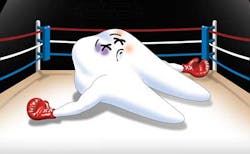Are state meetings down for the count?
By Lauren Burns
Attendance at dental conferences across the country is dwindling, with some convention coordinators reporting an average decrease in attendance of 4% to 8% each year. I've spoken with sources across the country to find out why conferences aren't as popular as they used to be, and what strategies they're using to combat low attendance.
It seems everyone is seeing a drop in attendance at state meetings. What's to blame? "We are seeing a decline in attendance in dental meetings across the country, regardless of the size," says Amanda Tran, Assistant Executive Director for the Washington State Dental Association. "This is a combination of competitive CE and the economy. We also see vendors reducing the number of dental meetings in which they participate; some are hiring marketing agencies to do shows for them, with some combining companies into single booths. This used to be a trend — it is now a reality."
Another factor could be reduced reimbursement by Delta Dental. In 2011, Delta Dental in Washington cut their payments to dentists by 15%. It's possible that dentists reacted by cutting costs elsewhere — often foregoing conferences in order to save money. The Pacific Northwest Dental Conference has seen a drop in numbers over the last few years: in 2010, their attendance was 8,147. That number dropped in the two years following, to 8,100 in 2011, and 7,663 in 2012.
I spoke with Crystal Bradford, Marketing Assistant with the Dental Trade Alliance, about what she has noticed about their preview show. "We've definitely seen a trend as far as attendance goes. We're seeing a decrease in attendance every year — about 4%." What strategies are they using to boost attendance? "We've started branching out to other markets and we start marketing earlier. At the conference, we've started giving away food, including beer and wine, which has been a big hit. In recent years, we've added networking lounges — one in the open, and one that is semi-private — which have been successful. We're thinking about expanding on the lounges. People really enjoy them!" Free food is always welcome, but is it enough to combat the cost of closing a practice to attend a meeting?
Even the Star of the North meeting saw a 4% drop in attendance between 2011 and 2012, from 9,002 to 8,602, says Shelly Conlin, Assistant Director of Meetings at the Minnesota Dental Association.
Some associations, however, are seeing positive trends in attendance. Richard Stevens, Executive Director of the West Virginia Dental Association, claims that attendance at the WVDA Annual Session has remained "relatively stable," with about 18% to 22% of members attending every year. (In 2011, their total attendance was 310.)
How, when other states are noticing a decrease in attendance, has the WVDA Annual Session maintained consistent attendance? Well, for one, it's held at The Greenbrier Resort, and who wouldn't want to go to that meeting? But Stevens has a few tricks up his sleeve as well.
"A few years ago, I changed the format of the meeting. It used to be spread out over four days so there was a lot of down time, wasted time. So I changed the meeting format to one full day just on Friday, the most preferred day by dentists to do a meeting course. No frills, just a full day of meetings and clinical programs – and I made Saturday a half day."
Some dentists, he says, still come for four days. And what do they do during that time? "They enjoy the resort! Some dentists bring their families and make a vacation out of it. For dentists who come solely for professional reasons, they don't have to waste any time, and they only have one night of lodging to pay for, plus, they're able to work more, so they make and save money." Win-win.
Unfortunately, not every state can have their meeting at a resort (or can they?). Even if a resort is out of the question for your state's venue, there are more feasible options to consider. John Bobb-Semple, Convention Coordinator for the Oklahoma Dental Association, also claims to see a decrease in attendance.
"We alternate our location between Tulsa and Oklahoma City, so attendance often depends on the city." Still, the numbers aren't growing. To get attendance up, the ODA has changed the weekend the convention is normally scheduled "in order to eliminate scheduling conflicts with other popular events."
It seems small changes are being made across the country in an effort to battle low attendance numbers. Will they make a big difference, or do bigger changes need to be made? One thing I know for sure — a weekend at a resort may be more appealing to attendees than a weekend at a downtown hotel. But the ultimate question remains ... just because someone comes to a dental convention, will he or she visit with exhibitors?
